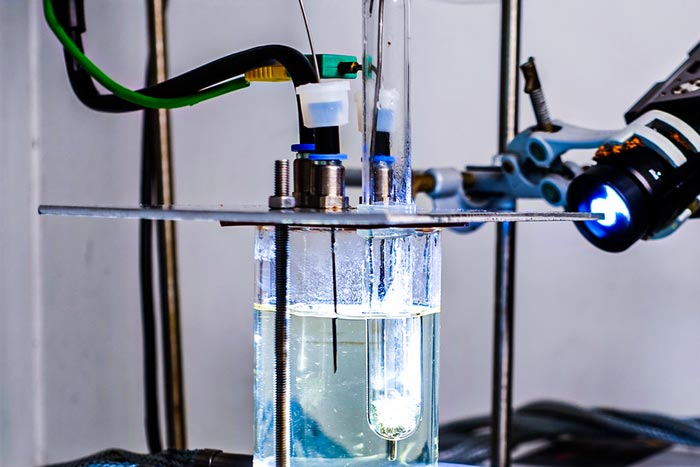How fine bubbles lead to more efficient catalysts

Experimental setup
Credit: HI ERN / Thomas Solymosi
Newly discovered effect boosts productivity of green hydrogen transport processes.
Catalysts are of utmost relevance for the production of chemicals and energy storage with hydrogen. Researchers at the Helmholtz Institute Erlangen-Nürnberg for Renewable Energy (HI ERN) and Friedrich-Alexander-Universität Erlangen-Nürnberg (FAU) have now discovered that the formation of bubbles in the pores of a catalyst can be essential for its activity. Their findings help to optimize catalyst materials for reactions in which gases are formed from liquids – and which play a central role in a future green hydrogen economy.
Catalysts accelerate chemical reactions without being consumed by themselves. A large number of reactions in nature and industry only work thanks to their help. For example, catalysts are used in around 80 percent of all chemical production processes and also play an important role in technologies for the chemical storage of hydrogen.
In most cases, so-called heterogeneous catalysts are involved, which are in a different aggregate state than the actual reaction partners. Solid, porous catalysts are particularly important here, as they can be separated very well from liquid or gaseous reaction products.
Researchers at HI ERN and FAU have now discovered: The productivity of this type of catalysts for gas generation reactions can be markedly increased if gas bubbles form particularly easily in the catalyst pores.
“This additional factor, which significantly determines the reaction rate, was previously unknown. Until now, it was assumed that the reaction rate was determined only by the chemical surface reaction or by the transport of molecules to the active centers of the catalyst,” explains Prof. Dr. Peter Wasserscheid, director of the Helmholtz Institute Erlangen-Nürnberg, a branch of the Jülich Research Center, and head of the Chair of Chemical Reaction Engineering at FAU.
Increasing productivity by a factor of 50
The discovery was made using a reaction that could play a key role in the transport of green hydrogen in the future. To this end, hydrogen is stored and transported bound to a liquid carrier medium – in this case LOHC (“liquid organic hydrogen carrier”) – and later released from it.
The technology is considered to be extremely safe and easy to handle. The faster hydrogen can be released from the carrier medium with the aid of a catalyst, the more compact and powerful that technology can be used.
The researchers at HI ERN and FAU were able to show that 50 times more hydrogen is released from the carrier medium per unit of time under the same conditions when the formation of gas bubbles in the pores of the catalyst is induced in the process.
The reason for the enormous difference: “Normally, the system produces only dissolved hydrogen during catalytic hydrogen release. Saturation then quickly sets in in the liquid phase around the active centers of the catalyst,” says Peter Wasserscheid.
The bubbles in the catalyst pores, on the other hand, act like tiny pumps. They help to remove the released hydrogen. “Once a bubble has formed in a catalyst pore, the growing bubble collects the formed hydrogen. When the bubble then detaches into the surrounding liquid, the loaded hydrogen carrier flows back into the pore and the process starts all over again,” Peter Wasserscheid explains the principle.
The formation of bubbles, known as nucleation, can also be induced artificially, for example by chemically modifying the catalyst surface or by a mechanical stimulus. The findings shed new light on performance-limiting factors in heterogeneous catalysis, which are of very high relevance especially for the green hydrogen economy of the future.
The results were obtained in collaboration between the teams of Professors Jens Harting, Matthias Thommes, Nicolas Vogel and Peter Wasserscheid in the DFG Collaborative Research Program 1452 “Catalysis at liquid interfaces” and have just been published in the prestigious journal Science Advances.
Journal: Science Advances
DOI: 10.1126/sciadv.ade3262
Method of Research: Experimental study
Subject of Research: Not applicable
Article Title: Nucleation as a rate-determining step in catalytic gas generation reactions from liquid phase systems
Article Publication Date: 16-Nov-2022
Media Contact
All latest news from the category: Life Sciences and Chemistry
Articles and reports from the Life Sciences and chemistry area deal with applied and basic research into modern biology, chemistry and human medicine.
Valuable information can be found on a range of life sciences fields including bacteriology, biochemistry, bionics, bioinformatics, biophysics, biotechnology, genetics, geobotany, human biology, marine biology, microbiology, molecular biology, cellular biology, zoology, bioinorganic chemistry, microchemistry and environmental chemistry.
Newest articles

Innovative 3D printed scaffolds offer new hope for bone healing
Researchers at the Institute for Bioengineering of Catalonia have developed novel 3D printed PLA-CaP scaffolds that promote blood vessel formation, ensuring better healing and regeneration of bone tissue. Bone is…

The surprising role of gut infection in Alzheimer’s disease
ASU- and Banner Alzheimer’s Institute-led study implicates link between a common virus and the disease, which travels from the gut to the brain and may be a target for antiviral…

Molecular gardening: New enzymes discovered for protein modification pruning
How deubiquitinases USP53 and USP54 cleave long polyubiquitin chains and how the former is linked to liver disease in children. Deubiquitinases (DUBs) are enzymes used by cells to trim protein…



